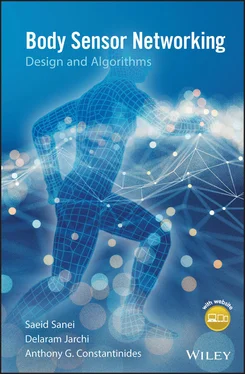Parkinson's: a degenerative brain disorder. The cause is generally unknown but believed to be genetic or due to environmental factors [41]. Physiologically, the dopamine generators of the brain fail in generating sufficient dopamine as the result of death of cells in the substantia nigra in the midbrain region [42]. Diagnosis of typical cases is mainly based on symptoms such as tremor, rigidity, slowness of movement, difficulty in walking, dementia, depression, and anxiety.
Pick's disease: a rare form of dementia and similar to Alzheimer's, except that it often affects only certain brain zones. It has unknown causes and people with Pick's disease have abnormal substances (called Pick bodies and Pick cells) inside nerve cells in the damaged areas of the brain.
Seizure and epileptic seizure;: a temporary loss of control often, but not always, accompanied by convulsions, unconsciousness, or both. Most common types are epileptic seizures, or seizures, are caused by sudden abnormal electrical discharges in the brain. An epileptic seizure, also known as an epileptic fit, seizure, or fit, manifests itself in the form of a brief episode of signs or symptoms due to abnormal excessive or synchronous neuronal activity in the brain [43]. The outward effect can vary from uncontrolled jerking movement (tonic–clonic seizure) to something as subtle as a momentary loss of awareness (absence seizure). Diseases of the brain characterised by an enduring predisposition to generate epileptic seizures are collectively called epilepsy [44]. On the other hand, for nonepileptic seizures the brain activity remains normal. Nonepileptic seizures have no identifiable physical cause, but they are believed to be physical reactions to psychological stress, change of emotions, in some cases due to tumour in the brain, or as symptoms of hypertension.
Brain tumour: a growth of cells in the brain that multiplies in an abnormal, uncontrollable way. Brain tumours can be malignant, slow growing, or benign. The most common brain tumour is a glioma, which has different types including astrocytomas, glioblastomas, oligodendrogliomas, mixed gliomas, and ependymomas. Some grow slowly while others grow more quickly.
Meningioma: a common brain tumour. It starts in the meninges, the tissue covering the brain and spinal cord, and is usually benign. A lymphoma is a cancer of the lymphatic system. It rarely starts in the brain. An acoustic neuroma is a benign tumour of the hearing nerve. Another benign brain tumour that starts in cells lining blood vessels is a haemangioblastomas.
Tumours that start in the pituitary gland, which helps control hormones, are also benign. There are also tumours which start in the spinal cord and they are usually benign. Tumours of the pineal gland, such as germinomas and teratomas, are rare. They can be slow or fast growing. Medulloblastoma tumours are rare in adults but more common in children.
In the next chapters of this book we will see how single or multiple sensor systems can record and detect the clinically important features related to most of the above abnormalities.
Human development, often referred to as developmental psychology, explains the changes in human cognitive, emotional, and behavioural capabilities and functioning over the entire life.
On the other hand, the availability of monoclonal antibodies, routine production of genetically altered animals, and new understanding of the genetic code have contributed to the exploration of how genetics interacts with development and early experiences to influence both vulnerability to disease and resistance to age-related decline.
The combination of biology and society makes us what we are and what we do. The three main elements of biology contributing to human behaviour are: (i) self-preservation; (ii) the reason for self-preservation, reproduction; and (iii) a method to enhance self-preservation and reproduction [45].
As another important biological effect, biological rhythms are related to the changes in mood and consequently the human behaviour. These rhythms control much of the body's normal functions, including performance, sleep, and endocrine rhythms as well as behaviour. These functions are primarily regulated by the circadian clock, a cluster of nerves located in the hypothalamus in the brain. The circadian clock relies on environmental cues to regulate its function, primarily light cues from the day/night cycle. Any shift in these cues, such as by travel resulting in jet lag, can alter the sleep cycle and have a detrimental effect on normal circadian rhythms. In addition, season changes, which are accompanied by a decrease in the number of daylight hours, can negatively impact the function of the circadian clock, primarily the secretion of melatonin to induce sleep. If the alterations in biological rhythms are sufficiently strong, they may lead to mood disorders including mild depression and seasonal affective disorder [46].
There are two major categories of biological rhythms: endogenous and exogenous. Endogenous rhythms come from within the organism and are regulated by the organism itself, for example the body temperature cycle, brain rhythms, or heart rate. Exogenous rhythms are the result of external factors, such as a change in the seasons or transition from day to night. The environmental stimuli referred also to as zeitgebers, from the German for ‘time givers’, help to maintain these cycles. They include sunlight, noise, food, and even social interaction and help the biological clock maintain a 24-hour day.
There are many factors influencing biological rhythms. A cluster of approximately 10 000 nerve cells located on the suprachiasmatic nuclei (SCN) found on the hypothalamus in the brain. The circadian clock's primary function is to interpret external changes of light and darkness, as well as social contact, in order to establish diurnal rhythms. It is not uncommon for the circadian clock to be disrupted temporarily; events such as changes in work schedule from day to night, changing time zones, and to some extent old age can impact the consistency of circadian rhythms.
The circadian clock relies heavily on changes in light to determine day/night transitions. During the night, SCN emits melatonin hormone, which induces sleep. The process of wake to sleep itself has its own stages and each stage has its own duration [17].
Another major disruptive factor related to the circadian clock's interpretation of light is seasonal change. During the winter months, there are fewer daylight hours. As a result, the level of melatonin secretion increases along with the number of hours of darkness. The normal cycles may also be interrupted by changing one's daily habits, for example changing feeding time, following a gradual force-to-sleep or sleep depriving.
In addition to these major influences there are a variety of other environmental factors that may have an impact on biological rhythms. One of them is caffeine. A series of experiments on caffeine revealed differences in the effects of the drug depending on time of day. In the morning caffeine has been shown to hinder low impulsiveness, while the opposite is true in the evening [47]. This finding suggests that low impulsiveness and high impulsiveness differ in the phase of their diurnal rhythms, resulting in a difference in the effects of caffeine.
By establishing an understanding of various environmental factors that influence biological rhythms it is possible to draw connections between the significant time shifts and changes in nature and mood disorders.
Moreover, the influence of those factors may be quantified by developing a hybrid measurement system incorporating measures of brain activity, heart rate, and respiration as well as changes in the level of adrenalin in the blood over time.
2.6 Summary and Conclusions
Читать дальше












